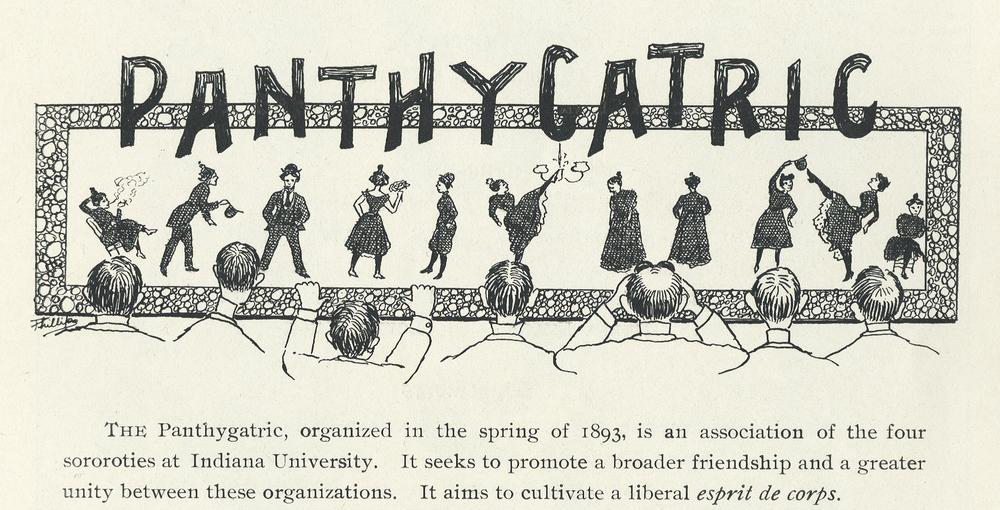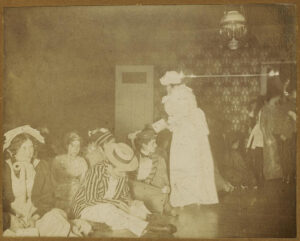
The word Panthygatric looks and sounds unappealing. However, the women it involved would tell you otherwise. In the late 1890s through the early 1920s, sorority women from the then-four houses on the Bloomington campus would come together to plan an exciting banquet. The idea actually stemmed from the fraternities, who were forming an extremely elaborate and expensive party. They called it the “Pan-Hellenic” dance. Originally, women were invited, but the more elaborate the planning got, the more they wanted it to be without females.
Rule 1: Never mess with a woman and her party plans.

To spite the fraternities, the women decided to throw an even better party. They chose not to invite the men, and in a fun twist of fate, the fraternities Panhellenic dance was cancelled, whereas the women’s dance became an annual tradition.
What happened at these mysterious Panthygatrics? Sorority sisters would wear their house colors but they each had unique costumes. These included everything from a sailor, to a boy, to a ballerina, to a football player. They wore masks to keep their identity concealed and were very secretive as to how they would arrive at the venue to avoid their identity being given away. There was dancing, toasts, and lots of food. Women were able to talk and meet new people without any of the typical social pressures. Ironically enough, the mysteriousness of the dance and its activities is what gave it all of its publicity and attention.
In 1906, three men were caught looking into the window, trying to get a glimpse of this unique event. While they were caught before getting a decent look and escorted out, one of them decided to turn that quick peek into a scandal. Writing a letter to the The Daily Student (the present day Indiana Daily Student), he wrote (under the initials G.A.R.) of the Panthygatric scene he saw, saying how unladylike and wrong it was for young, respectable women to dress and act in such a disturbing manner. This letter sparked a response from Mary Breed, the Dean of Women, who had been in attendance that night. She argued there had not been any shenanigans; her accounts insist everything was innocent and fun. The editor of the The Daily Student, Robert Thompson, was told to write a retraction since the article from G.A.R. made the women who attended look bad to the public. Robert refused, saying the note was a joke and should have been taken as such. He also noted that he was not there to clear the article before it was published, so he should not be punished for it.

The Trustees declared him in the wrong and suspended both him and William Mattox (another member of The Daily Student) until they resigned from the student newspaper. When they finally left the newspaper staff, they were reinstated to Indiana University at students. Before you start feeling bad for William and Robert, A Bedford Weekly newspaper article states that this was not the first incident with the boys putting “alternative facts” in The Daily Student. They had been warned to stop numerous times.

The Panthygatric continued for years to come, with different incidents involving men arising over the years — from the guys sneaking in to steal desserts or dressing as women in an attempt to slip in unnoticed. Bouncers were placed at the doors, but if anyone got around them, they were met with women holding buckets of cold water. Even local businesses got into the spirit, selling products geared toward the dance!
During World War I, the Panthygatric was cancelled and resumed for only a few years following. In its heyday however, hundreds of female students and faculty attended and enjoyed the event.
2 Comments
The photo Mr. Hatfield references can be found in our online photo database at http://purl.dlib.indiana.edu/iudl/archives/photos/P0085993 – it is a SUCH a wonderful slice of student life and we are so appreciative of this gift to the IU Archives! (along with Edna’s papers!)
My great Aunt, Edna Hatfield Edmondson attended I.U. in the teens. I had a photo of her with other women dressed up as boys and I wondered for years what that was all about.
In 2018 I donated my photos and other documents to I.U. Archives at the Herman B. Wells Library and that’s when I found out what was going on in the photo.
My straight-laced Great Aunt dressed up a a boy? How could it be? I guess we all had fun when we were young.